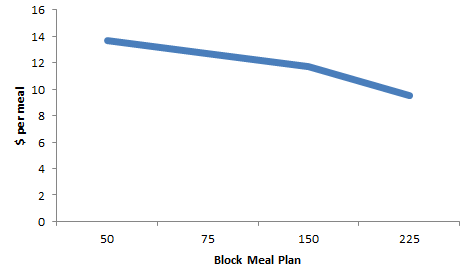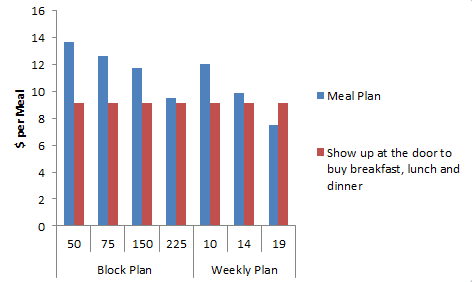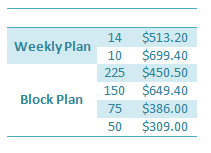Economics of Eating at Lehigh
April 30, 2011 in Editorial
 |
 |
 |
Choosing the right meal plan can be a difficult thing to do. There’re many options, and the combinations of meals and dining dollars only makes the choice more difficult. In this post, Centives decided to take a look at the meal plans and determine their various values. Beware if you’re on anything other than the 19 weekly meal plan; the results are likely to shock you.
The easiest meal plans to evaluate are the block plans. These plans offer students a set number of meals to use throughout the semester, and multiple meals can be used in each meal period if the student chooses. Thus, they offer a fair amount of freedom. Centives looked at how much each meal costs if you buy into the various block plans. The general trend in these block plans follow the theory of economies of scale. The larger the number of meals in the block plan, the less you pay per meal. For the 225 and 150 meal block plans, the costs per meal, including the guest meals, are $9.48 and $11.71 respectively. The cost per meal in the 75 meal block plan is $12.67 and $13.70 per meal for the 50 meal block plan.

Economics of Scale in the Block Plan
What’s stunning is that the door prices for eating in the dining halls are:

For anybody on the 50 or 75 meal block plan it would be cheaper to show up at the door and buy entrance to the dining halls by paying a maximum of $12.25  rather than pay $13.70 or $12.67 per meal. The 150 block plan only makes economic sense if you consume nothing but specialty dinners, which would mean that you would have to consume 1.4 specialty dinners every day of the 15 week semester (and remember, you can’t swipe your friends in.) Any other combination would be cheaper than the $11.71 the 150 block plan will cost you. The 225 block plan seems more reasonable since it only costs $9.48 per meal, but if you were to buy one breakfast, one lunch and one dinner per day then that would still only cost you an average of $9.16 per meal.
rather than pay $13.70 or $12.67 per meal. The 150 block plan only makes economic sense if you consume nothing but specialty dinners, which would mean that you would have to consume 1.4 specialty dinners every day of the 15 week semester (and remember, you can’t swipe your friends in.) Any other combination would be cheaper than the $11.71 the 150 block plan will cost you. The 225 block plan seems more reasonable since it only costs $9.48 per meal, but if you were to buy one breakfast, one lunch and one dinner per day then that would still only cost you an average of $9.16 per meal.
Then there are the weekly meal plans. The weekly meal plans set a limit to the number of meals a student can purchase using the meal plan every week, and starts anew once the week is over. These plans offer slightly less freedom to students as they only require a student to plan his or her meals for a week, not an entire semester, and they limit how many meals you can use per day and per meal. These calculations have been made under the assumption that a semester is fifteen weeks long. This can, however, differ for each student depending upon his or her finals schedule. The 19 meal plan costs $7.52 per meal, the 14 meal plan costs $9.91 per meal, and the 10 meal plan costs $12.03 per meal.

Economics of Scale in the Weekly Plan
Once again the 10 meal plan only makes sense if you consume 1.4 specialty dinners a day, even the 14 meal plan would only make sense if you skip breakfast and buy only lunch and dinner every day. The 19 meal plan makes the most economic sense but any meals that remain unused are lost in the weekly plans.
If we assume that a student goes to the dining hall and buys breakfast, lunch and dinner every day, then this is the difference between what they would pay in cash at the door and what they pay for in the meal plan. As the graph demonstrates only the 19 meal weekly plan makes sense:

 In the worst case scenario, if you’re on the 50 block plan and you use it to buy breakfast, lunch and dinner then you end up paying an extra $4.53 for every meal that you consume simply because you chose to be on the meal plan! Obviously the graph above would be different if the assumptions didn’t hold.
In the worst case scenario, if you’re on the 50 block plan and you use it to buy breakfast, lunch and dinner then you end up paying an extra $4.53 for every meal that you consume simply because you chose to be on the meal plan! Obviously the graph above would be different if the assumptions didn’t hold.
So far we’ve assumed that you’ll be eating at the dining halls. What if you didn’t and converted them into money at the rate of $4.35 per meal. You would lose $1201.25 with the 225 meal block plan, $1162.50 with the 150 meal block plan, $623.75 with the 75 meal block plan, and $467.50 with the 50 meal block plan. For the weekly meal plans, you would lose $940.25 for the 19 meal plan, $1216.50 for the 14 meal plan, and $1212.50 for the 10 meal plan.
If we assume that the cost per meal to Sodhexo is $7.52, the amount they charge under the 19 weekly meal plan (this is a conservative estimate since it assumes that Sodhexo makes no profit of off students on this plan), then we can estimate the amount of profit that Sohexo makes of off you depending on which meal plan you have:

Good article, I’ve fine similar calculations before and settled on the 300 dining dollar plan as noted by the commenter above. What is also fun to calculate is how much money is wasted buying stuff from upper during the bulk sale. Like take a case of gatorade for example which they sell for $46.99. If you use all meals to buy it ($4.35 per meal so 11 meals) at the 225 block (most common) that case costs you $104.28. Now a case if gatorade has 24 bottles so you’re paying $4.35 per bottle (which normally retail for $1.50 or less. Even at the retail price of $46.99 you are still buying them for almost $2 a bottle. And here I thought buying in bulk saved you money…
yeah but your meal plan, by the end of the semester, is a sunk cost. you’re not getting that money back so you might as well get something out of it by purchasing ridiculously priced gatorade.
with that said, go with dining dollars over meals
[…] Economics of Eating at Lehigh […]
You people have got to be kidding, you do this [long overdue] study and neglect to include the meal plan that makes THE MOST economic sense. I’m talking of course about the 300 dining dollars plan. The plan comes with 300 dining dollars and costs you only 250 dollars. Furthermore, you can add more to you account at ANY POINT in the semester with a 20% bonus. This means that for every 10 dollars you spend, you get 12 dollars added to your account. This means that eating breakfast is cheaper (only $5.00 per meal) than ANY plan you could buy. It means that lunch is also cheaper (8.54) than all but the 19 per week plan, and that dinner is cheaper (9.38) than anything but the 19 meal per week plan. Given that this plan is just plain cheaper than every other plan in every circumstance (except specialty dinner which is not much of a consideration to most students, and which they charge you extra for should you try to use a meal for it) I will only consider the 19 meal per week plan from this point forward. If you assume that you will eat breakfast lunch and dinner each day at a dining hall (which i find to be a foolish assumption, but since that is how you wrote your article, I will continue it) then with the Dining dollars plan you would be spending 22.92 vs. the 19 meal plan where you would be spending 22.56. Most people would agree that this 40 cents is economically insignificant for people attending lehigh in the first place, but for those sticklers, I will continue.
To this point we have only considered eating at Lower UC, Rathbone, and Broadhead student restaurants. Many (if not most) students that eat on campus will eat at Pandinis, Upper UC, Lucy’s, Common Grounds, Subversions, Hawk’s Nest or Baker’s Junction at some point over the semester, and many more will eat there several times per week. When you use a meal purchased from a meal plan at such a place (and only some places accept them, and some only at some hours) you receive 4.25 in credit toward anything you wish to purchase. I realize that everybody buys different things at these places, so just for the sake of this argument, I will assume that a typical meal costs 7.50 (this is roughly the price of a dinner and drink at either pandinis, upper uc, subversions, or hawks nest). Now the obvious problem is that your 4.25 will not cover the 7.50 that you need to pay, so either you’ll pay in dining dollars which is a very limited source of funds (19 meal plan has only 50 dining dollars per semester) in which case you will quickly run out, or you will use multiple meals (which you can’t do on the 19 meal plan, but i’ll mention just for the sake of mentioning it). Now lets look at what you would pay with the dining dollars meal plan… just $6.25. The 19 meal per week plan would cost you 7.52 + any dining dollars/cash you have to spend, and the most popular meal plan at lehigh, the 225 block plan, would cost you 2 meals, which comes out to 18.96 (but you get to add something like a candy bar in the round out the 8.50 credit you’ll get from your two meals). Just to drive this point home a little further, if you were to take the money you spend using the 225 block plan on 1 meal at upper uc, and spend it instead on 1 meal at upper uc using the dining dollars plan you could buy the following: 2 meals (from any restaurant, a drink of any kind, a pint of ben and jerry’s ice cream/frozen yogurt, and if you havn’t chosen the most expensive of all the previous items, something else like a bag of chips or 12 pack of soda to take back to your room/share with your friends. That is quite the difference.
Now, for my favorite section, the part that this article glossed over, but I find incredibly important. WHAT IF I DON’T WANT TO EAT 19 MEALS PER WEEK? With the 19 meal plan, too bad, you already paid for them. With the 225 plan the number is 15 per week, and… you can spend that money at upper uc (for half of what you paid to get it) and buy soda, food for your friends, etc. With the 300 Dining dollars plan… you don’t have to pay for any food you don’t eat. Ever. As the end of the semester approaches you can add 20 dollars at a time (it is very convenient to do so at the desk outside baker’s junction on the 2nd floor of the UC).
I would indeed be amiss if I did not report the drawback to the 300 dining dollars plan, and that is this: The university only lets you purchase it if you live in campus square, trembly, sayre, or off campus. So that only applies to 40-50 percent of the school, but for those 40-50 percent, the choice is clear.
Other notes: You also did not mention carte-blanche for people who think eating 25 meals per day is necessary, but w/e, no big deal.
Er, would you like to write for Centives?
(We’ve updated the post by adding a link to your comment at the top.)